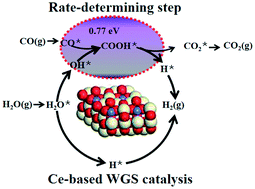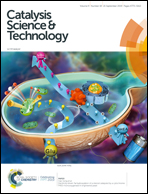Molecular-level understanding of reaction path optimization as a function of shape concerning the metal–support interaction effect of Co/CeO2 on water-gas shift catalysis†
Abstract
In this work, the active sites generated in hydrogen reduction and the reaction pathways for the water gas shift (WGS) reaction over Co/CeO2 catalysts were studied by in situ XAS and XPS coupled with DFT+U calculations. In reactions over fresh CeO2 and Co/CeO2 of spindle-, cube-, rod- and sphere-morphology, the CO conversion was less than 30% and did not show much variation across the catalysts. After in situ H2 treatment at 400 °C for 1 h, the Co/CeO2 catalyst of spherical morphology shows an excellent reaction rate and stability. In situ XAS, XPS and H2-TPR results revealed that the H2 treatment results in the strengthening of cobalt–ceria interaction, which is essential for the WGS reaction. It is apparent that the shape of CeO2 has a strong influence on the strength of metal–support interaction which affects the degree of cobalt reduction. According to the results of DFT+U calculations, the WGS reaction follows the associative mechanism on reduced Co/CeO2 catalysts, and the formation of the carboxyl group is found to be the rate-limiting step with an activation barrier of 0.77 eV. Interestingly, the carboxyl intermediate species over pure reduced CeO2(111) are unstable, while these intermediate species can exist stably over the reduced Co/CeO2(111) surface via the strong interaction between Co and Ce, which will promote the WGS performance. The findings of the present study offer new insights into Ce-based catalysts that are suitable for the WGS reaction.

- This article is part of the themed collection: 2019 Catalysis Science & Technology HOT Articles


 Please wait while we load your content...
Please wait while we load your content...